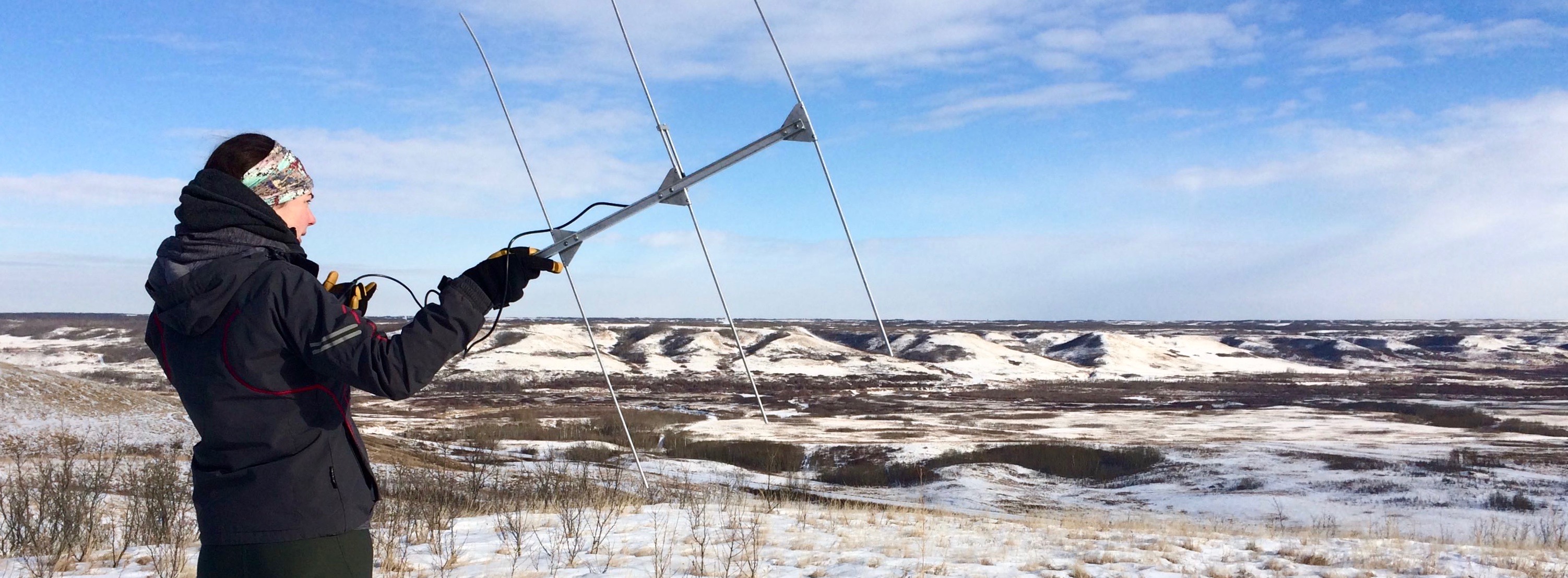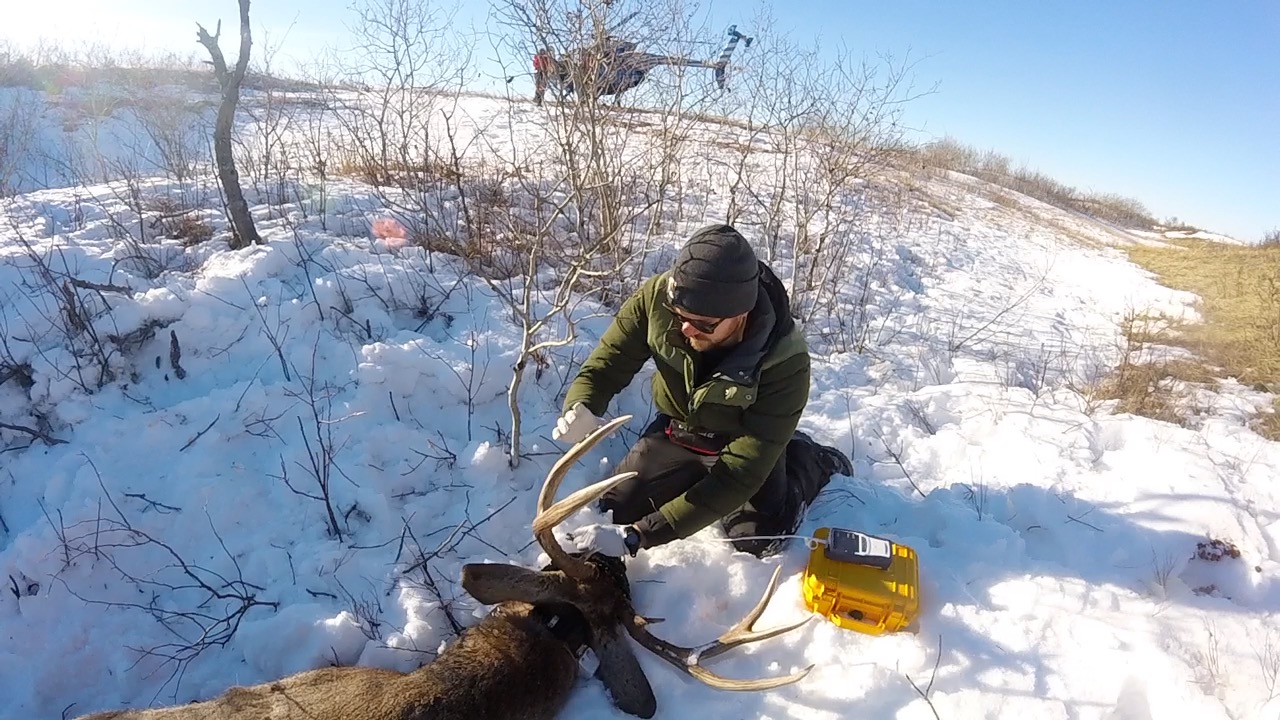February 2020 – Remote Camera Maintenance
Every few months, our remote cameras in the field need to be serviced, which includes replacing data cards and batteries. Furthermore, cattle and deer are often curious, and occasionally they just need a good scratch, so our cameras can take a bit of a beating! For this reason, we also reposition cameras to ensure they are taking quality photos. This is no small task! With the help of an undergraduate volunteer, we spent five days snowmobiling throughout the study site to service all of our cameras. When data cards are full, they are collected and the images are subsequently tagged with the species, group size, age and sex of individuals, and other parameters such as distance among individuals and occurences of direct contact between deer.

Undergraduate student Gary Elaschuk repositioning a remote camera.
February 2020 – Behavioural Observations
Starting in February of this year, we are back in the field on a weekly basis conducting behavioural observations on mule deer. We locate deer using GPS collar data which is transmitted to us online. Our goals are mainly to determine group size and composition of deer in the study area (Cresthill Grazing Reserve), as well as to record the frequency and duration of proximity events (when deer occur within a certain distance of one another) and direct contact among deer. In order to effectively locate deer in the field, we obtain GPS coordinates from the last known location of a given collared deer. We drive close to this location and proceed on foot to reduce noise. We then use radio telemetry to pinpoint the direction in which the deer is located. Slowly but surely, remaining silent and downwind of the deer, we can often find our focal deer. Using binoculars or a spotting scope, we then keep our sights on the deer for as long as possible to collect as much data as we can. This data, as described above, will help us determine contact rates in the heterogeneous environment of east-central Alberta’s aspen parkland, and on a broader scale, contribute to our understanding of the spread of CWD in Alberta.

Research technician Greg Melvin locating a collared deer using radio telemetry
January 2020 – Deer Capture
In January 2020, 39 mule deer (13 males and 26 females) were collared with GPS-proximity collars in the Ribstone Creek Heritage Rangeland/Cresthill Grazing Lease southeast of Edgerton. The capture operation took place over five days with captures carried out by a professional heli-capture contractor. This marks the fourth and final deer capture for this project. A total of 131 deer have been captured and collared for the project since 2017 (including a few recaptures) in two separate study areas, providing us with a large and robust data pool. Collared deer continue to be monitored by means of GPS data transmitted to an online webserver, as well as by direct observation in the the field.

Field coordinator Johanna Thalmann after collaring a captured mule deer in January.
October 2019 – Fall Pellet Plots
Following the round of pellet plot sampling conducted in the spring, we will again be sampling our study area in early October for deer, moose, elk, coyote, and cow feces (pellets). The purpose of this sampling is to use the abundance and distribution of the sampled pellets in two main ways. First, it allows us to look at how the distribution of these species across our study area is changing seasonally by comparing the data collected in our spring versus fall pellet plots. Second, we can estimate habitat-use of these species by looking at the distribution of pellets across different habitats. We can also use these estimations of habitat-use to validate our estimations of habitat-use from the analysis of the GPS locations of the GPS-collared deer (this analysis is known as a resource selection function). Additionally, very fresh deer pellet samples are collected as part of a collaborative study at the University of Calgary that is testing the feasibility of detecting CWD agents (prions) in feces.

From top to bottom: moose, elk, deer, and hare pellets that were sampled during the spring 2019 pellet plots.
August 2019 – Remote Camera Data Analysis

A collared male mule deer that was photographed by one of our remote cameras. Note the unique collar tape patterns and ear tags which help us identify individuals during direct behavioural observations.
In August we are in the process of sorting through and analyzing our remote camera images. We are currently using the remote camera images to quantify the number, duration, and types of contact events between mule deer (the wooden stakes you see in the images below help to estimate distance between deer during contact events). We will also use the remote camera data to estimate mule deer habitat-use, which, in conjunction with pellet plot data, can be used to validate our estimations of habitat-use from our analysis of the GPS locations of the GPS-collared mule deer.

An example of an indirect contact event between two mule deer photographed on one of our remote cameras. The wooden stakes in the image help us to determine distance between individuals in each image.
July 2019 – Vegetation Surveys
With the help of some awesome volunteers, the field team completed vegetation surveys during the week of July 21, 2019. The data collected from these surveys will be compared to vegetation data collected in east-central Alberta as part of the North Border Deer Study during 2007-2008 . Vegetation surveys help us to understand how the availability of deer forage varies across different vegetation communities.

This Prunus species (chokecherry) is a preferred forage plant of deer, and is one of the dominant shrub species in our study area.
May 2019 – PRION 2019 Conference
Peter Smolko (Postdoctoral Fellow) presented a poster on Chronic Wasting Disease (CWD) in deer at the PRION 2019 conference in Edmonton, AB from May 21-24. The poster illustrated findings on the spatial and temporal patterns of CWD risk for deer in Alberta. View the PDF version of the poster here.

March 2019 – Direct Observations

Liam Horne observing a group of mule deer, including one collared female.
January 2019 – Deer Capture
In January 2019, 32 mule deer (9 males and 23 females) were collared with GPS-proximity collars in the Ribstone Creek Heritage Rangeland/Cresthill Grazing Lease south-east of Edgerton. The capture operation took place over five days with captures carried out by a professional heli-capture contractor. Click the link to view our UofA 2019 CWD Mule Deer Capture Newsletter.
February 2018 – Collar recovery
At the end of February, we went out to the field to find collars that were deployed in March 2017 on the Canadian Forces Base Wainwright. We found our collars (often buried in snow) and they have been shipped back to the manufacturer to retrieve the data. Next step: analyses!

Eilidh Smith listens to radio-collar signals from collars that have dropped off deer.
January 2018 – Deer Capture
In January 2018, 25 deer (8 males and 17 females) were collared in the Cresthill Grazing Lease south-east of Edgerton with GPS-proximity collars. The capture operation took place over two days with captures carried out by a professional heli-capture contractor.

Phil Walker attaches a pulse-oximeter to a sedated deer.
December 2017
In December 2017 Eilidh Smith and Evelyn Merrill represented the project at the Canadian Forces Base Wainwright’s hunt to help facilitate the collection of pellets from the deer for experimental CWD testing with Dr. Gilch at the University of Calgary. During December the decision was also made to expand the study site into the Cresthill Grazing Lease and Dunn Lake Cattle Association approximately 35 km east of Wainwright, near Edgerton. Thanks to Ashley Kelly, Ksenija Vujnovic, Katy Delves, Gerry Bennet of Alberta Tourism, Parks and Recreation and Pat Porter, Zoey Zapisocki, Scott Stevens and Glenn Mack of Alberta Environment and Parks for their assistance with permits. We also thank the landowners in the Cresthill Grazing Lease and Dunn Lake Cattle Association areas for their support.
June 2017
Between June and October 2017, female deer were monitored in the field to observe social groupings and determine fecundity. Six of the females were thought to have fawns with them on one or more observations and the remaining 12 were unconfirmed.
March 2017
In March 2017 35 deer were collared on the Canadian Forces Base Wainwright; of these deer, 15 does were fitted with GPS-proximity collars to record contact rates between deer.
